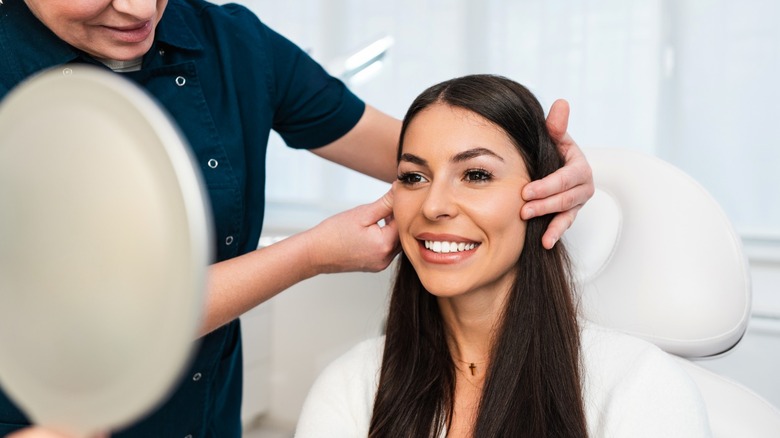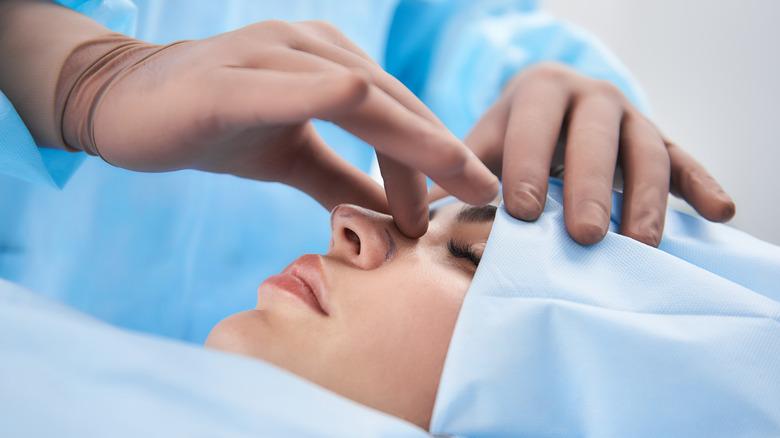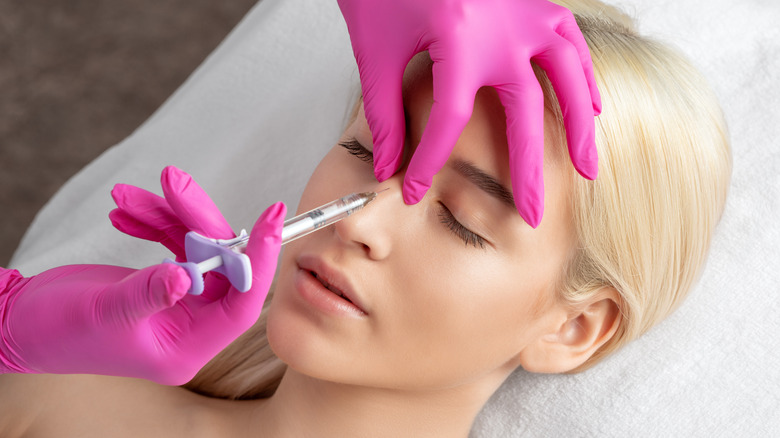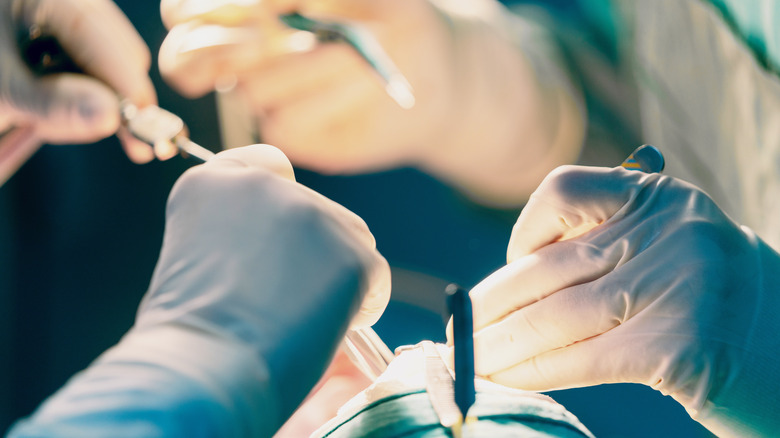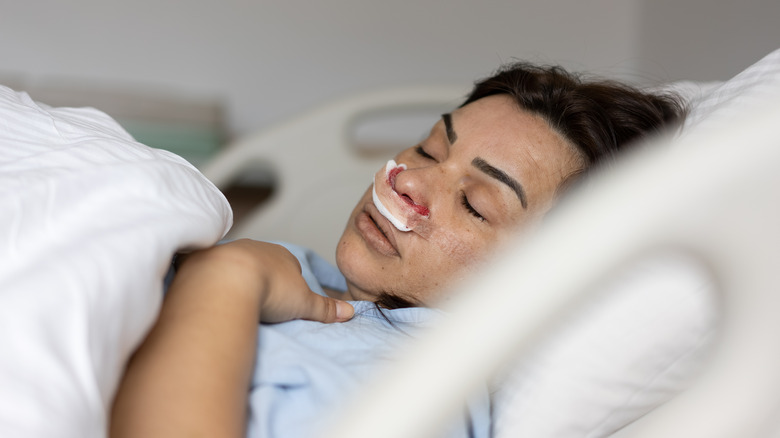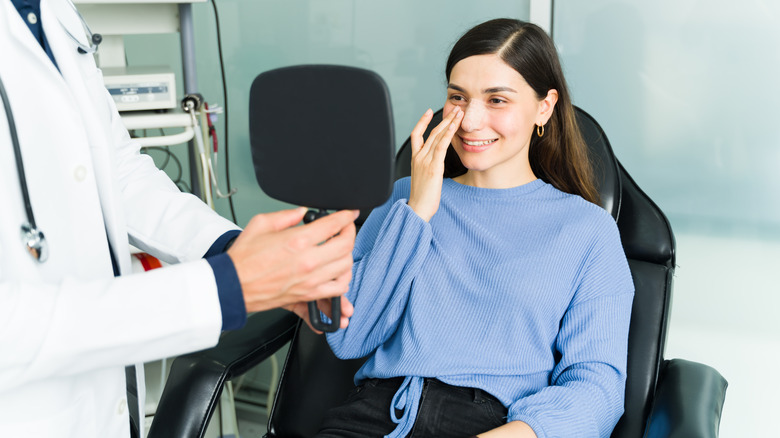Thinking About A Nose Job? Here's Everything You Need To Know Before Taking The Plunge
Maybe you just have a small ridge on your nose that makes wearing glasses uncomfortable, or maybe everything about your nose makes you feel self-conscious. Either way, you might be thinking about getting a nose job. It's one of the most commonly performed cosmetic procedures, so you're definitely not alone in wanting to make changes to your nose. While many who've had a nose job are happy with it — such as the 91% of reviewers on RealSelf.com who gave it a "Worth It" rating — some have felt differently. One famous example is Bella Hadid, who shared in an interview with "Vogue" that she wished she didn't get a nose job so early in life.
No matter how you feel about your nose, when it comes to getting plastic surgery, there's a lot to think about. Not only will you be making a permanent change to your face, but getting a procedure could impact you financially, emotionally, and mentally, too. As with any surgical procedure, there are also potential health risks to consider.
Doing a little research can be helpful, and you might discover that a more temporary solution, like a liquid nose job, or using makeup to contour your nose, is right for you. Along with taking time to think about what you want to change and whether you're ready for something permanent, doing research on the procedure can help you decide if you're ready for plastic surgery or if something else is a better fit.
Understand rhinoplasty basics
A rhinoplasty, often called a nose job, is a surgery performed to change the appearance or function of the nose. While it is usually done for cosmetic reasons, it can also help those with a deviated septum improve their breathing. It can also be done to fix an injury or birth defect. Some typical adjustments made during a nose job are the reduction of a hump or dip on the bridge, a change in the angle or size of the tip, a change in the width of nostrils or bridge, and opening breathing passages. Those who have finished growing are good candidates for a rhinoplasty, as are those who are healthy enough to go under general anesthesia.
There are two main kinds of surgical rhinoplasties, open and closed. Open rhinoplasty is performed when major structural changes need to be made, as it can make it easier for the surgeon to see what they are doing. It involves making incisions in the skin and cartilage and separating it from the bone. A closed rhinoplasty is less intensive and is a better option when only minor adjustments are needed. During a closed rhinoplasty incisions will be made from within the nose to alter its shape. Some prefer this method because it can cause less scarring, which may mean a shorter recovery period. For those looking for yet another option, liquid nose jobs are a non-surgical approach that's growing in popularity.
Alternatives to a traditional nose job
Even if you're sure you want a nose job, you may be apprehensive about going under the knife. Not only is a permanent commitment intimidating, but the potential health risks of getting surgery can be as well. A liquid nose job can be a great option for those who don't want to make a commitment or who would like to test drive what some changes might look like before getting a traditional nose job.
If you opt for a liquid nose job, dermal fillers will be used to reshape your nose. By carefully injecting fillers under your skin, a doctor can balance out asymmetry, reduce a bump, and shape the tip of your nose. They tend to be cheaper than traditional nose jobs, the average cost being $1000, according to WebMD.com. You'll be able to walk out directly after the procedure, and many will be able to see results immediately. Besides some potential bruising at injection sites, there are typically no scars. The results aren't permanent, with fillers fading between six months to three years. If you're unhappy with your liquid nose job, it is also possible for your fillers to be dissolved by your doctor.
If a liquid nose job seems like more than you want to deal with, learning some makeup tricks can help. Makeup tutorials about how to contour your nose can be great for masking small imperfections, as well as for testing out changes you'd like to make to your nose.
Research the procedure & potential doctors
Doing research to find the right plastic surgeon is an important step when getting a nose job. Also, the more you know about the actual procedure and risks, the easier it will be for you to decide if you're comfortable with it. Researching the hospital or facility the surgeon uses is a good idea, too, because the anesthesiologist and nurses they work with can impact your experience. When going to consultations, check in with your gut feelings about the surgeon and any staff you meet.
Choosing an experienced surgeon who specializes in rhinoplasty can be the difference between having a great experience or getting a nose job you're not happy with. Because there are so many different kinds of plastic surgeries, some doctors may specialize in just a few. Just because a surgeon is experienced in general doesn't necessarily mean they will be experienced with nose jobs.
One important thing to look for is whether or not a plastic surgeon is board-certified. This ensures that they can perform the procedures that they advertise to you. After you've found a doctor with expertise in nose jobs, you also need to look at the before and after pictures they have online. This can give you a sense of how other patients' rhinoplasties have turned out, and can help you decide if that doctor's aesthetic is in line with what you want.
Know the look you want but be open-minded
Understanding your goals with rhinoplasty is super important, even before you make consultation appointments to meet with surgeons. The clearer an idea you have about what you want, the easier it will be for you to communicate that to your plastic surgeon, and the more likely you are to be happy with your results. If you have a bump on the bridge of your nose that bothers you but want to maintain the overall personality of your nose, you need to be clear about that. If you're looking for more dramatic changes, you need to be clear about that, too. Depending on the surgeon, they may be able to create a mock-up or image of what your nose job may look like after surgery, which can help ensure that you're on the same page.
That said, it's also helpful to be open-minded regarding your expectations. While lots of changes can be made to the nose, it might not always be possible for a surgeon to replicate an exact look. For example, if you decide you want your nose to look like Angelina Jolie's, a doctor might be able to use that as a guide, but they may not be able to replicate her nose on your face. Plastic surgeons will also often take your overall look into account. The goal is usually not just to change your nose but to ensure that it fits the rest of your face and helps create facial harmony.
Familiarize yourself with the risks
No matter what kind of surgery you get, going under the knife always involves risk. This is the case even if you're healthy, and have a great doctor. Part of what introduces risk is that you may need to go under general anesthesia. Obesity, smoking, drinking, diabetes, neurological disorders, high blood pressure, and other conditions can increase the risk of having problems while under anesthesia. Breathing problems are possible, as is bleeding and developing an infection while anesthetized. There are also some common side effects to be aware of, such as a sore throat caused by the breathing tube, vomiting, chills, and temporary confusion (per the American Society of Anesthesiologists). Risks aren't limited to anesthesia, though, risks are also associated with the surgery itself.
You could also experience things like nerve damage, which can cause sensations like pain and numbness, which could be permanent. There could be a change or loss in sense of smell, lasting scarring, swelling, pain, as well as breathing problems. However, one of the most common concerns is that you may end up with a final result that you don't like. Some may come to realize that, while they did not like their nose before surgery, they liked it even less afterward. While having these issues may not necessarily be likely, being aware of the risks is still important as you go through the decision-making process.
Consider your finances
Even if you've decided you're ready to take the leap, you still need to consider the financial aspect of getting a nose job. Costs can vary depending on where you live, the surgeon you choose, and how extensive your surgery will be. According to plasticsurgery.org, the average rhinoplasty cost is $5,483, not including any other anesthesia or hospital fees. While some may be tempted to seek out plastic surgeons who offer especially cheap rates, it's important to remember that going to a surgeon who isn't board-certified or who uses unsafe practices could lead to a bad result.
Saving up funds for the procedure is always an option, but that may not be feasible for some. If you have a deviated septum, then there is a possibility that your surgery could be covered by health insurance, since it would be considered a medical issue. Typically, though, if it's considered a cosmetic procedure, you will need to pay for it out of pocket. Some may find that a low- or zero-interest credit card is a good option for financing this procedure, while others may opt for a personal loan or a medical loan. When researching a plastic surgeon, it is also a good idea to look at their payment policies and learn whether or not they offer their own credit cards or payment plans that can be tailored to your needs.
How to prepare leading up to the procedure
If you've decided to get a nose job, your nerves might be on edge as you anticipate going under the knife. Making sure you're prepared in the weeks leading up to the procedure can help put your mind at ease and ensure the surgery and recovery period go smoothly. One of the first things you'll need to do is check with your surgeon about any medications you take. Medications like aspirin and some herbal supplements could interfere with anesthesia as they increase bleeding, so you may need to discontinue them for a while before surgery. Some may also need to stop smoking before the procedure and cut out alcohol. In some cases, blood tests may be required.
There are other things you'll need to do to get ready for the recovery period, too. You'll need to take some time off work or school, as well as arrange for help with childcare if you have young children. You'll also want to make sure you have some essentials to stay comfortable while recuperating. Some things that may help are cotton swabs, baby wipes, nasal spray, cough drops, ice packs, and a neck pillow. Arnica gel can help with bruising, and a quality concealer will probably come in handy, too. Of course, having a show picked out to binge and some of your favorite snacks and drinks (and straws) on hand won't hurt either.
What happens during the procedure
Whether you get an open or closed rhinoplasty, the doctor will first mark the areas that need to be worked on, on your nose. You will then be put under general anesthesia, although some nose jobs can be performed with local anesthesia. Depending on what's being done, the surgery can take between one and a half and three hours.
For an open rhinoplasty, incisions may be made in your nostrils and at the center base of your nose so the surgeon can lift the skin away from your bone. The techniques the surgeon uses will have a lot to do with the precise changes that are being made. During the surgery, the plastic surgeon will reshape or remove pieces of cartilage and bone. Various tools, like a chisel, hammer, scalpel, rasp, and elevator are used to do this.
When finished, any cuts made will be sewn up with dissolvable stitches. A splint or a cast will be put in place that will be removed in about a week, at your first follow-up appointment. Because it is an outpatient procedure, you'll leave once you wake up from the anesthesia. You won't be able to drive, so make sure to have someone there to pick you up.
What to expect during your first week after the procedure
The healing process can feel and look different for everyone, especially within the first week of recovery. During this time, you can expect plenty of swelling and bruising, so don't be disappointed if your nose appears even larger than before the surgery. You may also experience some pain, particularly within one to three days after the surgery.
Pain medication is often provided, and if you do not want to take pain meds, extra-strength Tylenol can help keep pain under control (ibuprofen should be avoided, as it can increase the risk of bleeding). Expect to feel stuffed up if you have a splint in your nose. A dry mouth is also common along with feeling tired since you'll have to sleep on your back with your head elevated for about two weeks.
During this time, you won't be able to wear glasses, so having some contacts on hand is ideal. Avoiding sneezing and blowing your nose is also important as is keeping your cast dry. At the one-week mark, you may have your first follow-up appointment, where your splint is removed. This will be your first true look at your new nose, and it can be a good time to talk to your doctor about when you can resume usual activities.
How long is the healing and recovery process?
While you may still have some swelling and bruising, the two-week mark is when the worst of it should be behind you. This point is also when many return to work and resume most of their normal daily activities. By three to four weeks, many begin working out again. That said, it's important to avoid any sports or activities where your nose may be bumped for at least three months after your procedure.
Over time, the swelling in your nose will continue to go down and by the six-week mark, your bones should be stable again. Many doctors have a follow-up at around six to eight weeks, where they may take after photos. While the bulk of the swelling should be down by then, your nose may still have a minute amount of swelling, even up to a year after the surgery.
These are general timelines, and results can vary from person to person. Talking to your doctor about any concerns you have is always important, and can help you feel more supported throughout the process. It can also help you be more prepared for any unexpected emotional reactions you experience after the procedure. Even if you're excited about your new nose, making a permanent change can feel like a lot to deal with, especially while you're still recovering. Remember: Taking things one day at a time can help you ease your mind and take some stress out of the recovery process.
